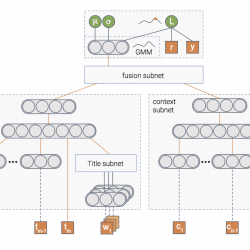- Taboola Blog
- Data Science
Imagine you’re walking down the street and you see a nice car you’re thinking of buying. Just by pointing your phone camera, you can see relevant content about that car. How cool is that?! That was our team’s idea that awarded us first place in the recent Taboola R&D hackathon aptly named – Taboola Zoom! Every year Taboola holds a global R&D hackathon for its 350+ engineers aimed at creating ideas for cool potential products or just some fun experiments in general. This year, 33 teams worked for 36 hours to come up with ideas that are both awesome and helpful to Taboola. Some of the highlights included a tool that can accurately predict the users’ gender based on their browsing activity and an integration to social networks for Taboola Feed. Our team decided to create an AR (Augmented Reality) application that allows a user to get content recommendations, […]
Introduction One of the key creative aspects of an advertisement is choosing the image that will appear alongside the advertisement text. The advertisers aim is to select an image that will draw the attention of the users and get them to click on the add, while remaining relevant to the advertisement text. Say that you’re an advertizer wanting to place a new ad titled “15 healthy dishes you must try”. There are endless possibilities of choosing the image thumbnail to go along with this title, clearly some more clickable than others. One can apply best practices in choosing the thumbnail, but manually searching for the best image (out of possibly thousands that fit this title) is time consuming and impractical. Moreover, there is no clear way of quantifying how much an image is related to a title and more importantly – how clickable the image is, compared to other […]
In the first post of the series we discussed three types of uncertainty that can affect your model – data uncertainty, model uncertainty and measurement uncertainty. In the second post we talked about various methods to handle the model uncertainty specifically . Then, in our third post we showed how we can use the model’s uncertainty to encourage exploration of new items in recommender systems. Wouldn’t it be great if we can handle all three types of uncertainty in a principled way using one unified model? In this post we’ll show you how we at Taboola implemented a neural network that estimates both the probability of an item being relevant to the user, as well as the uncertainty of this prediction. Let’s jump to the deep water A picture is worth a thousand words, isn’t it? And a picture containing a thousand neurons?… In any case, this is the […]
Now that we know what uncertainty types exist and learned some ways to model them, we can start talking about how to use them in our application. In this post we’ll introduce the exploration-exploitation problem and show you how uncertainty can help in solving it. We’ll focus on exploration in recommender systems, but the same idea can be applied in many applications of reinforcement learning – self driving cars, robots, etc. Problem Setting The goal of a recommender system is to recommend items that the users might find relevant. At Taboola, relevance is expressed via a click: we show a widget containing content recommendations, and the users choose if they want to click on one of the items. The probability of the user clicking on an item is called Click Through Rate (CTR). If we knew the CTR of all the items, the problem of which items to recommend […]
Understanding what a model doesn’t know is important both from the practitioner’s perspective and for the end users of many different machine learning applications. In our previous blog post we discussed the different types of uncertainty. We explained how we can use it to interpret and debug our models. In this post we’ll discuss different ways to obtain uncertainty in Deep Neural Networks. Let’s start by looking at neural networks from a Bayesian perspective. Bayesian learning 101 Bayesian statistics allow us to draw conclusions based on both evidence (data) and our prior knowledge about the world. This is often contrasted with frequentist statistics which only consider evidence. The prior knowledge captures our belief on which model generated the data, or what the weights of that model are. We can represent this belief using a prior distribution p(w) over the model’s weights. As we collect more data we update the […]
As deep neural networks (DNN) become more powerful, their complexity increases. This complexity introduces new challenges, including model interpretability. Interpretability is crucial in order to build models that are more robust and resistant to adversarial attacks. Moreover, designing a model for a new, not well researched domain is challenging and being able to interpret what the model is doing can help us in the process. The importance of model interpretation has driven researchers to develop a variety of methods over the past few years and an entire workshop was dedicated to this subject at the NIPS conference last year. These methods include: LIME: a method to explain a model’s prediction via local linear approximation Activation Maximization: a method for understanding which input patterns produce maximal model response Feature Visualizations Embedding a DNN’s layer into a low dimensional explanation space Employing methods from cognitive psychology Uncertainty estimation methods – the focus of […]
Now that more than a year has passed since our first deep learning project emerged, we have had to keep moving forward and delivering the best models we can. Doing so has involved a lot of research, trying out different models, from as simple as bag-of-words, LSTM and CNN, to the more advanced attention, MDN and multi-task learning. Even the simplest model we tried has many hyperparameters, and tuning these might be even more important than the actual architecture we ended up using – in terms of the model’s accuracy. Although there’s a lot of active research in the field of hyperparameter tuning (see 1, 2, 3), implementing this tuning process has evaded the spotlight. If you go around and ask people how they tune their models, their most likely answer will be “just write a script that does it for you”. Well, that’s easier said than done… Apparently, there […]
Back in 2012, when neural networks regained popularity, people were excited about the possibility of training models without having to worry about feature engineering. Indeed, most of the earliest breakthroughs were in computer vision, in which raw pixels were used as input for networks. Soon enough it turned out that if you wanted to use textual data, clickstream data, or pretty much any data with categorical features, at some point you’d have to ask yourself – how do I represent my categorical features as vectors that my network can work with? The most popular approach is embedding layers – you add an extra layer to your network, which assigns a vector to each value of the categorical feature. During training the network learns the weights for the different layers, including those embeddings. In this post I will show examples of when this approach will fail, introduce category2vec, an alternative method […]
Large production pipelines in TensorFlow are quite difficult to pull off. Training small models is easy, and we mostly do this at first, but as soon as we get to the rest of the pipeline, complexity rapidly mounts. One reason is that the “Computation Graph” abstraction used by TensorFlow is a close, but not exact match for the ML model we expect to train and use. How so? Typically a model will be used in at least three ways: Training – finding the correct weights or parameters for the model given some training data. Often done periodically as new data arrives. Evaluation – calculating various metrics during training on a different data set to evaluate training quality or for cross validation. Serving – on-demand prediction for new data There could be more modes. For example we could re-train an existing model or apply the model to a large amount of […]








